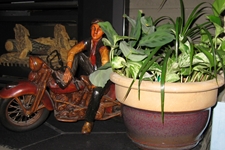Houseplants Bring Gardening Indoors
By Jos Van Hage
 Houseplants are a great way to add living color to the home as well as aid in purifying the air we breathe. Growing plants indoors can be done very successfully if you follow a few simple tips.
Houseplants are a great way to add living color to the home as well as aid in purifying the air we breathe. Growing plants indoors can be done very successfully if you follow a few simple tips.
A houseplant was once a wild native plant that has been domesticated and selectively bred to adapt to indoor conditions but still requires the basic needs as it would if grown outdoors in its native state and that is light and moisture.
When choosing a houseplant for a certain area of the home take note of the amount of light and type of light the area receives.
Some plants require more light than others but all plants require light. Light is needed in the photosynthesis process of transforming light into food energy for the plant.
If the area receives only low light which is a dim reading light level the choice of plants are limited unless you are able to add additional light by using artificial light.
Low light plants are Chinese evergreen, Cast-iron plant and Dieffenbachia.
A moderate light area is an area which is 5-8 feet away from a window that receives no direct sunlight. Plants that will grow in moderate light are Norfolk Island pine, Grape or Devils ivy, Corn plant, Philodendrons, Peace lily and many of the ferns.
The next level of light is bright indirect light which would be a north-facing window and plants that grow well in this light are Schefflera, Aralia, Ficus and African Violets.
If you have an area that receives some direct curtain filtered sunlight a Lipstick plant, Asparagus fern, Clivia, Jade plant among most others will grow well there.
A very sunny location that receives more than 4 hours of direct sun each day should have cactus, Succulents and Aloe growing in it.
Of course it also depends on the time of year as during the winter months we receive much less sunlight than over the summer months.
Water and nutrients are also very important in keeping plants healthy. Most plants are killed by over watering rather than under watering. You want to make sure that the plant is not sitting in water for any period of time as this will cause the roots to rot. After you water the plant go back to it 30 minutes later and throw out any excess water. Allow the top layer of the soil to go slightly dry to the touch before watering again. Some plants require more water than others for example cactus over the winter may only need to be watered every few weeks. It also depends to the time of year on how much and often to water a plant.
Plants over the winter go into a semi-dormant state and so require less water than in the summer when they are in full growth.
Watering also depends on the pot as ceramic and clay pots (better for plants) will require more water than those grown in plastic or glazed pots that are not porous and so do not dry out as quickly. It is best to water when the plant needs it rather than on a set scheduled day as conditions is always changing, and water the plant thoroughly with room temperature water.
-Jos
Jos Van Hage owns two Art Knapp Garden Centres in the Prince George region:
- Highway 16 West
- Highway 97 North at Aberdeen
Previous Story - Next Story
Return to Home










